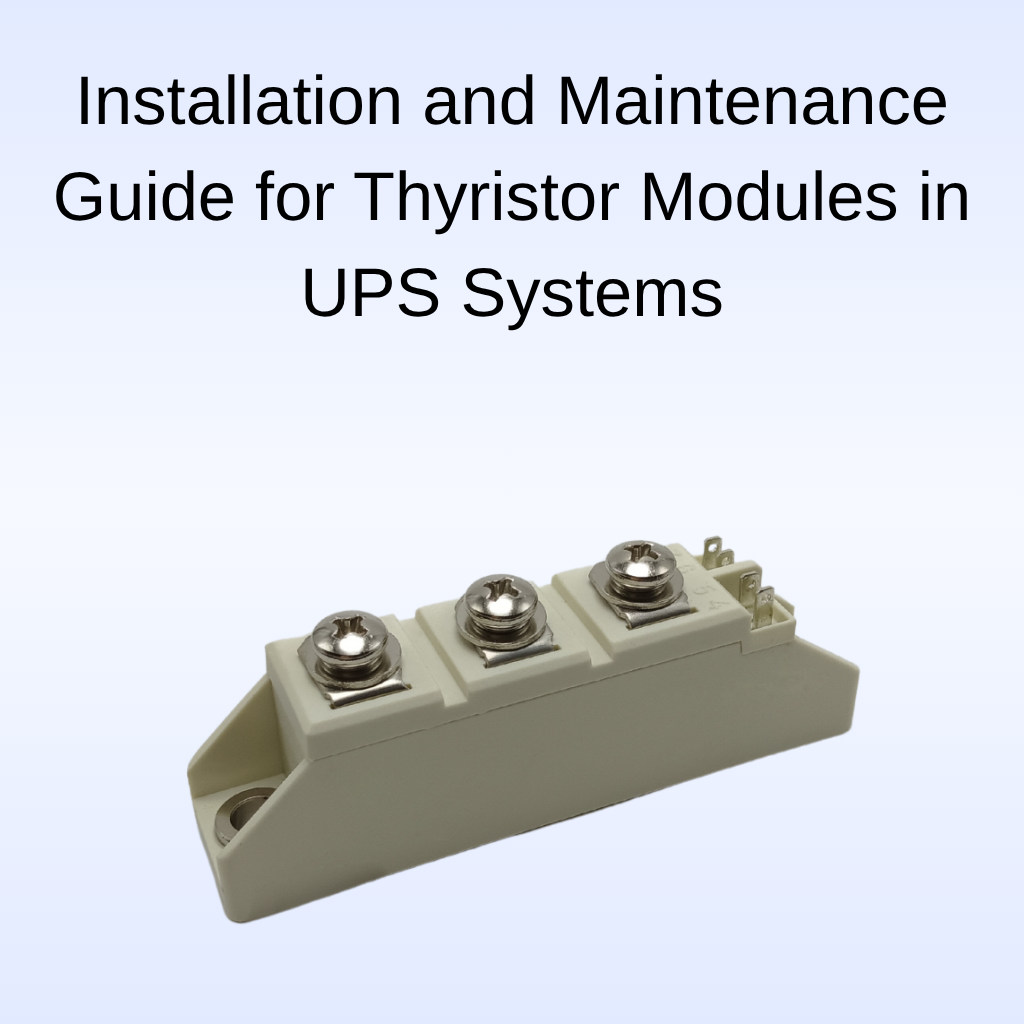Installation and Maintenance Guide for Thyristor Modules in UPS Systems
Thyristor modules are key components in Uninterruptible Power Supply (UPS) systems. They are responsible for controlling power flow, ensuring that sensitive equipment continues to operate during power interruptions. The installation and maintenance of these modules require careful consideration to ensure optimal performance, reliability, and longevity of the UPS system. This guide provides a comprehensive overview of the installation and maintenance of thyristor modules in UPS systems, focusing on key features such as high surge current, low on-state voltage, and industrial phase control.
Step 1: Installation of Thyristor Modules in UPS Systems
Proper installation is critical to ensuring that thyristor modules operate efficiently and reliably. The following key considerations should be taken into account during the installation of thyristor modules in UPS systems:
Compact Package and Space Requirements: Thyristor modules are often designed in a compact package for ease of installation. When integrating them into a UPS system, ensure that the installation space meets the size requirements and allows for adequate ventilation to prevent overheating. Proper air circulation is crucial for maintaining optimal performance.
Anodizing for Corrosion Resistance: Many thyristor modules are anodized to provide a layer of corrosion resistance. When installing the modules, it is important to inspect the anodized surfaces for any signs of damage. Anodizing enhances the durability of the modules, ensuring that they remain operational in harsh environments such as industrial settings, where moisture and other contaminants may be present.
Power Converter Integration: Thyristor modules are integral parts of the power converter circuit in UPS systems. During installation, ensure that the module is properly integrated into the power converter system to enable efficient conversion of DC to AC power. Proper wiring and connections must be established to facilitate smooth operation.
Handling High Surge Current: UPS systems are frequently exposed to high inrush currents during startup or load transitions. When installing thyristor modules, ensure that they are capable of handling high surge current. Modules designed to withstand high surge currents will protect the UPS system and the connected equipment from damage during sudden power fluctuations.
Step 2: Testing the Installation
Once the thyristor modules have been installed, it is essential to conduct a series of tests to ensure that the modules are functioning correctly within the UPS system:
Testing for Low On-State Voltage: After installation, check the thyristor modules for low on-state voltage. A lower on-state voltage results in reduced power losses and higher system efficiency. Ensure that the modules are operating within the desired voltage range to maximize efficiency.
Industrial Phase Control Testing: For UPS systems that serve industrial environments, the industrial phase control feature of thyristor modules ensures that the output voltage remains stable and reliable. Test the system to confirm that the phase control is functioning as expected, especially under varying load conditions.
Surge Current Testing: Conduct surge current testing to ensure that the thyristor modules can effectively manage high surge currents. Verify that the system can handle power surges without compromising performance or causing damage to the modules.
Step 3: Maintenance of Thyristor Modules
Regular maintenance is essential to ensure that thyristor modules in UPS systems continue to operate reliably over time. The following maintenance practices should be implemented:
Visual Inspection: Periodically inspect the thyristor modules for any signs of physical damage, such as cracks, discoloration, or corrosion. If any issues are detected, replace the damaged modules immediately to prevent further damage to the UPS system.
Cleaning: Over time, dust and debris may accumulate on the thyristor modules and other components of the UPS system. Clean the modules and surrounding components regularly to prevent overheating and ensure optimal performance. Use compressed air or a soft brush to remove dust without damaging the modules.
Thermal Management: Thyristor modules generate heat during operation, and improper cooling can lead to premature failure. Check the cooling systems, including fans and heat sinks, to ensure they are functioning properly. If the system is operating in a high-temperature environment, consider enhancing the thermal management to prevent overheating.
Surge Current Monitoring: Continuously monitor the system for any signs of surge current issues. Ensure that the high surge current handling capacity of the modules is not exceeded during high-power transitions. If frequent surge currents are detected, evaluate the UPS system’s load and performance to ensure that the thyristor modules are operating within their capacity.
Conclusion
The installation and maintenance of thyristor modules in UPS systems are critical to ensuring the reliability and efficiency of the system. By following best practices for installation, conducting thorough testing, and performing regular maintenance, the performance of the UPS system can be optimized. Key features such as high surge current tolerance, low on-state voltage, and industrial phase control play a significant role in ensuring the modules function efficiently, especially in demanding industrial environments. Proper installation and maintenance will extend the lifespan of the thyristor modules and contribute to the overall performance of the UPS system.
READ MORE:
Installation and Maintenance Guide for Thyristor Modules in UPS Systems: Optimizing Performance
Case Studies of Thyristor Modules in Uninterruptible Power Supply Systems: Applications in Industry
Case Studies of Thyristor Modules Used in Uninterruptible Power Supply Systems
Best Practices for Selecting Thyristor Modules in UPS Systems

